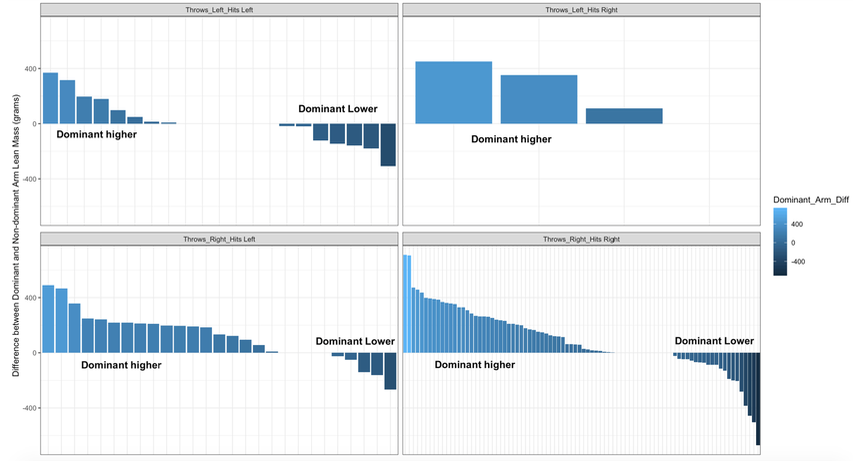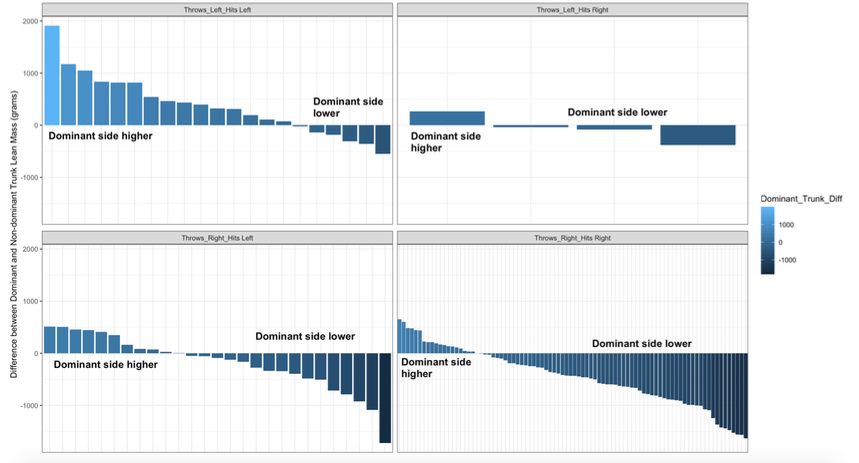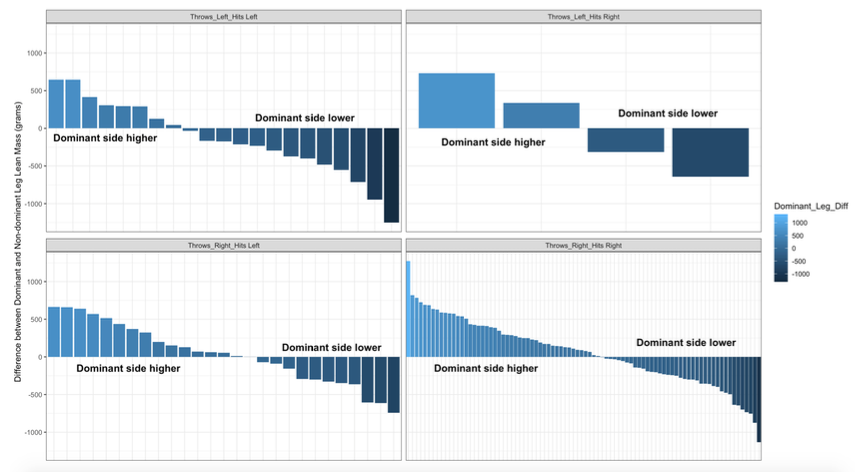Part 2 of our series on Baseball Player Data
We recently published a paper in the International Journal of Sports Medicine (Czeck et al., 2019) on body composition measures in over 200 collegiate male baseball players. In addition to measuring total body composition, we also examined the composition of throwing vs. non-throwing arms in these collegiate players. Baseball players present a unique population because the sport involves rotational movements; in most cases, rotational athletes will have mass asymmetries (e.g. muscle) because of the repetitive one-sided movements (i.e. throwing, hitting). However, unlike throwing events in some sports where there is a single dominant side (i.e., Track & Field), baseball players can have a dominant throwing side and a dominant hitting side and these sides could differ (e.g. Throws: Right; Hits: Left). In Part 1 of our baseball blog, we talked about some normative data in college baseball players and how it could be used. In Part 2, we will summarize the observations from the study and discuss asymmetries in baseball players.
Total body composition measures of male collegiate baseball players.
Due to the large sample size, we were able to separate our players into pitchers (n=92), catchers (n=25), outfielders (n=43), and infielders (n=41). What we observed was that infielders had significantly lower total lean mass than pitchers and outfielders. Additionally, outfielders had significantly lower total fat mass compared to pitchers and catchers. Even with these differences in lean and fat mass, we did not find any significant differences between positions in regards to total bone mineral density or visceral adipose tissue (VAT).
Throwing vs. non-throwing arm composition
I think what was more striking about the results of this study was in composition differences we observed between throwing and non-throwing arms. One would expect pitchers to have significant differences in the composition of their throwing and non-throwing arms and we did see that pitchers’ throwing arms demonstrated significantly greater total mass, fat mass, lean mass, and bone mineral density compared to the non-throwing arm. Outfielders also demonstrated the same differences as pitchers with bone mineral density significantly higher in their throwing vs. the non-throwing arm.

Asymmetries in Trunk and Leg Lean Mass in Baseball Players
In addition to arm asymmetries, rotational athletes may demonstrate trunk (torso) and/or leg asymmetries. Repetitive throwing and hitting could, potentially, cause asymmetrical lean (muscle) mass changes. Looking at the data for trunk lean mass asymmetry, it is interesting that players that throw left or right have a left side that is higher than the right side of their Trunk. Importantly, there was a very small sample of players that throw left and bat right (n=4) so drawing conclusions within this group is limited.


What does it all mean?
So what does it all mean? First, this is a small subset of all college baseball players and a smaller subset of all baseball players worldwide. This data provides normative data not only for total body composition, but also regional and symmetrical data. This information provides a jumping off point for understanding player and positional norms. Like anything, other data can be used with this information that will help add context and value. Additionally, tracking this information over time will provide more insight into each individual’s norms. One main finding of the study is that there were significant total and regional body composition differences across position for baseball players. It may be that a player’s total and regional body composition makes them more suitable to play a particular position. The other major finding was the differences in the composition of throwing vs. non-throwing arms. This observation indicates the sport’s demands (i.e., utilizing the throwing arm more frequently than the non-throwing arm) contribute to asymmetries in arm composition. For those that want more detailed information found in this paper, please contact the corresponding author Dr. Don Dengel (e-mail: denge001@umn.edu).
References
Czeck MA, Raymond-Pope CJ, Bosch TA, Bach CW, Oliver JM, Carbuhn A, Stanforth PR, Dengel DR: Total and regional body composition of NCAA division I collegiate baseball athletes. International Journal of Sports Medicine 40(7):447-452, 2019.
About the Authors:
Donald Dengel, Ph.D., is a Professor in the School of Kinesiology at the University of Minnesota and is a co-founder of Dexalytics. He serves as the Director of the Laboratory of Integrative Human Physiology, which provides clinical vascular, metabolic, exercise and body composition testing for researchers across the University of Minnesota.
Tyler Bosch, PhD is a Research Scientist in the College of Education and Human Development at the University of Minnesota, and is a co-founder of Dexalytics.